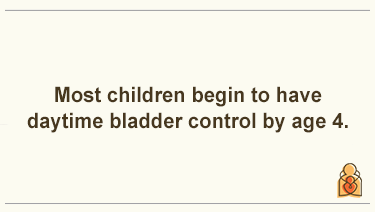By: Joseph McQuaid, MD, MPH, FAAP
Does this sound familiar? Your child is toilet trained, but still has frequent daytime accidents. It might be a common condition known as
voiding dysfunction, and your child isn't alone! As many as 20% of school-age children have at least one symptom of voiding dysfunction, according to some studies.
Voiding dysfunction is not typically diagnosed until a child is over age 4 and continues to have daytime accidents for at least 6 months after
toilet training ends.
Your Child's Bladder Function:
What's Normal, What's Not?
A healthy lower urinary system has two basic functions: it stores urine and empties urine (voiding). Typically, these abilities develop over time.

All infants start out incontinent, meaning they have no control over when their bladder empties.
Most children begin to have daytime bladdar control by age 4. Staying dry overnight―called nighttime urinary continence―usually follows within a few months after a child has daytime control.
Once children are toilet trained, if the bladder isn't storing or emptying urine the way it should, they may have symptoms including:
Too many or two few trips to the bathroom. The number of times children should empty their bladders each day depends on their age and the amount of fluids they take in. In general, everyone should urinate every 2 or 3 hours. But there may be an underlying problem with storing urine if a child pees an abnormally high or low number of times each day.
Urgency. A frequent, sudden, and unexpected need to pee can indicate an overactive bladder (OAB). This condition happens when muscles in the urinary tract squeeze at the wrong time. Kids with OAB often try to "hold it" (usually unsuccessfully) by crossing their legs. Most have frequent accidents and some develop urinary tract infections (UTIs).
Leakage. Urine may leak throughout the day (diurnal enuresis). In some cases, it may be triggered by laughing, sneezing or coughing. Or, it can happen at night―called
nocturnal enuresis. These problems may also point to a possible issue with urine storage.
Problems with flow. this can take different form, including:
Hesitancy: difficulty starting a urinary stream when a child is otherwise ready to pee. The child may stand over or sit on the toilet for several seconds or even minutes before the urine stream gets going.
Straining: a great effort is needed to start and finish emptying the bladder.
Weak or broken stream: when the flow of urine is either weak, like a dribble. Or it may have several, separate start and stop points.
Pain: a child may have pain or discomfort during urination, which is called dysuria.
Frequent constipation with daytime accidents. Studies show almost ALL children with voiding dysfunction also have some form of constipation or bowel dysfunction. In many cases, treating the constipation is addressed first, which can improve bladder symptoms.
What Causes Voiding Dysfunction in Children?
Voiding dysfunction is caused by an inability to appropriately store urine and completely empty the bladder. When children urinate, the bladder squeezes down and the urinary sphincter relaxes. When this voiding cycle doesn't happen as it should, it can result in poor bladder emptying. Sometimes this is due to a neurological problem, but often it's a learned (functional) problem.
Neurogenic causes. Children with nervous system (neurogenic) causes may have conditions from birth (congenital anomalies) that affect the spinal cord or brain such as
spina bifida or
cerebral palsy, or genetic disorders such as Williams Syndrome. These can affect the coordination between the bladder and urinary sphincter. Voiding dysfunction can also happen with
epilepsy,
diabetes, and
injury to the spine, but these are much less much less common of causes.
Functional causes. For some children with voiding dysfunction, there are no physical causes that can be narrowed down. These so-called "functional causes" or "non-neurogenic" cases of voiding dysfunction can come from
stress, for example, or poor toilet training habits. Some children become so caught up in activities that they forget or delay going to the bathroom. Not drinking enough fluids to fill up the bladder regularly also can contribute to a pattern of "holding it" too long. Posture on the toilet can also affect urinary symptoms.
How is Voiding Dysfunction Diagnosed?
Your pediatrician may refer you to a
pediatric urologist for an exam. The doctor may:
Ask about your child's urinating habits and bowel function. Often, a voiding diary―a daily log to track how much and how frequently your child urinates―is a good first step.
Take a family and social history. It helps to know if family members have or had similar problems, because bladder problems can sometime be hereditary. It is also helpful to understand more about the child's school environment and schedule. Sources of stress or changes in routine can contribute to urinary problems, such as an
adverse childhood event or trauma.
Order tests. These may include
imaging tests like an abdominal x-ray, kidney and bladder ultrasounds, or magnetic resonance imaging (MRI) of the spine. In some cases, it can be helpful to use x-rays to watch different parts of the voiding cycle with a voiding cystourethrogram (VCUG).
Uroflow testing can help determine problems with urine flow by having the child use a special toilet with measuring instruments.
How is Voiding Dysfunction in Children Treated?
Because voiding dysfunction often is tied to
urinary tract infections and VUR, it is best to treat the condition without delay. The specific treatment the doctor recommends will depend on what's causing your child's voiding dysfunction.
While surgery can help in some cases, there are many other treatment options that can be effective, particularly for children with functional causes of voiding dysfunction.
Non-surgical treatment options for children with voiding dysfunction:
Avoiding and treating constipation. By making sure children get enough
fiber in their diet, drink enough
water and other healthy beverages, and taking a prescribed laxative in some cases can improve constipation and voiding dysfunction at the same time.
Behavioral training for wetting. In some cases, the best treatment is to revisit potty-training basics. For daytime wetting, making sure the child urinates every 2-3 hours during the day, for example, and keeping track of fluid intake can help. For children with nighttime wetting, bed alarms often aid children in waking up in time to empty their bladders.
Pelvic floor therapy. Exercises to work on abnormal pelvic floor muscle contractions can help with voiding dysfunction. Some types of pelvic floor physical therapy for children use biofeedback in the form of video games, teaching children when it is the right time to relax or contract their pelvic muscles.
Medications. There are medications that may be recommended to help ease overactive bladder contractions and address certain types of incontinence.
Additional Information:
About Dr. McQuaid:
 Joseph McQuaid, MD, MPH, is an Assistant Professor of Urology at the University of Massachusetts and specializes in all aspects of pediatric urologic care. He completed his surgical training at Massachusetts General Hospital and his fellowship in pediatric urology at Boston Children's Hospital. Within the American Academy of Pediatrics, he is a member of the Section on Urology (SOU).
Joseph McQuaid, MD, MPH, is an Assistant Professor of Urology at the University of Massachusetts and specializes in all aspects of pediatric urologic care. He completed his surgical training at Massachusetts General Hospital and his fellowship in pediatric urology at Boston Children's Hospital. Within the American Academy of Pediatrics, he is a member of the Section on Urology (SOU).